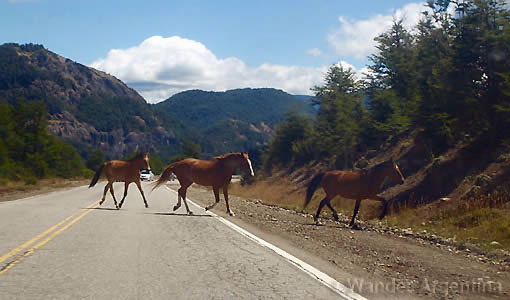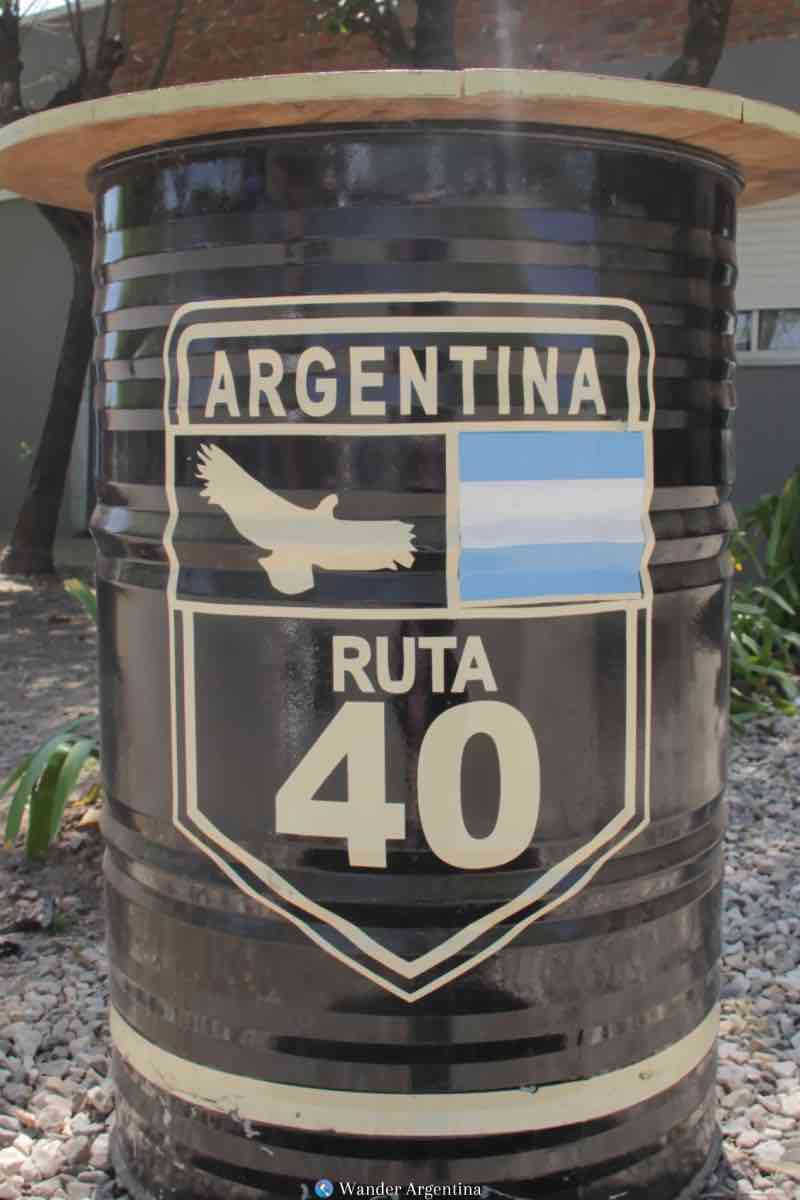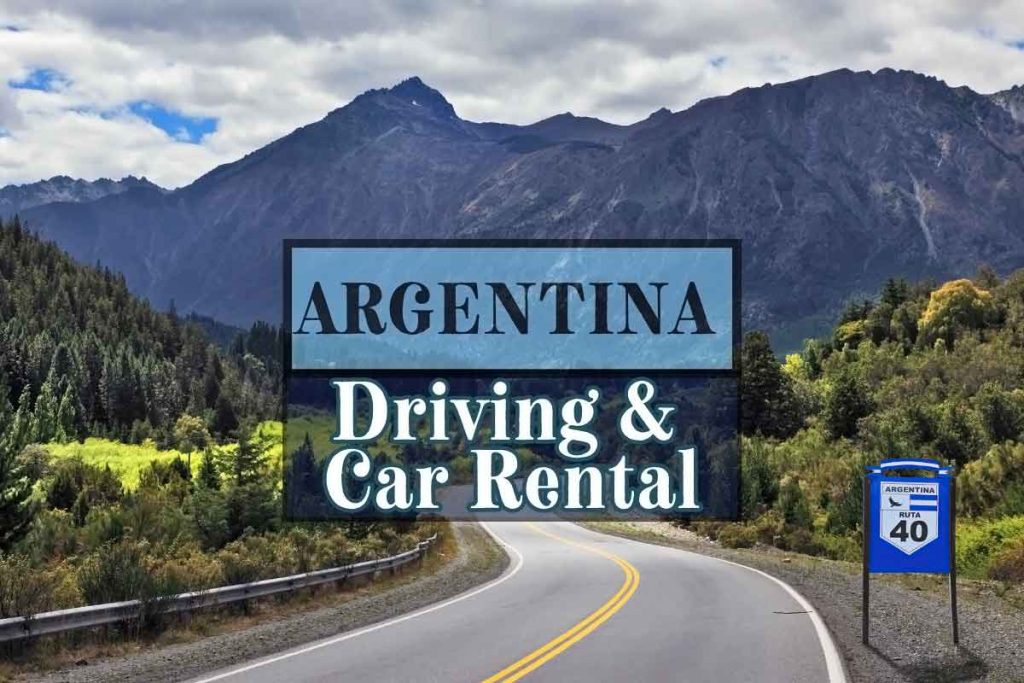Argentina is a huge country with many out-of-the-way scenic areas that lend themselves to road trips, particularly in Patagonia, Mendoza‘s wine country, the around the Andean Northwest and to visit small towns on the pampas.
Road Trip in Argentina!
Among the popular road trips for visitors is the Vuelta A Los Valles through Salta, with stops at colorful natural rock formations and the ghost town of Alemanía.
Almost everyone who has the good fortune to visit Bariloche or San Martín de Los Andes does Patagonia’s Seven Lakes Route, whether they take a tour or rent a car to do the trip on their own.
If staying in Puerto Madryn, the best way to visit the penguin reserve at Punta Tombo is by renting a car, to not be limited by the time constraints of a tour.
FAQ: Rules of the Road & Renting a Car in Argentina:
• What kind of driver’s license is required to rent a car in Argentina?
-Anyone with a valid license from their home country can rent or hire a car in Argentina, as long as they also hold a valid tourist visa and a credit card.
Those who have overstayed their visa might encounter problems.
You do NOT need an international driver’s license.
Almost all cars have a manual transmission, so those who don’t know how to drive a stick shift (or those from the U.K. not accustomed to shifting with the right hand) better learn quickly — hopefully before you go.
Learning how to drive a shift for the first time in frenzied Buenos Aires would be quite a steep learning curve!
• Can you rent cars at the Buenos Aires airport?
-Yes, you can rent a car ready for pick up at Buenos Aires International Airport, Ezeiza (EZE), or the domestic airport, Jorge Newbery (AEP) as well as at most other airports in major cities throughout Argentina.
Make sure to make car rental reservations in advance in popular destinations or during high season, or there may not be cars available.
Be aware that Buenos Aires has pretty aggressive, or chaotic driving to put it generously.
Anyone who has been to Italy will recognize that many Porteños (residents of Buenos Aires) are Italian descendants who aren’t interested in formalities such as car lanes, and like to loudly express their life’s frustrations via gratuitous honking.
These daredevils, particularly in Buenos Aires, enjoy pretending they are ‘the maestro‘ Argentina’s most famous race car driver, Juan Manuel Fangio.
(Interestingly, Fangio who people claim to see apparitions of in Chacarita cemetery, himself famously never had a driver’s license to drive on public streets his whole life — he said he was scared of the other drivers!)
Considering this, those thinking of renting a car at the airport should contemplate if they will feel comfortable driving from the international airport (32k from downtown Buenos Aires) after a long flight.
While it will be slightly more expensive upfront, you can always get a ride to your hotel and pick up the rental car downtown the following day after a good night’s sleep.
This option works out well because it is usually more expensive to pick up a rental car at the airport anyway.
Wander Argentina offers safe and friendly airport pickup in Buenos Aires, for those who’d prefer to be driven downtown, or you can arrange a shuttle.
If you do plan to rent a car in Buenos Aires, be sure that your hotel has parking, as finding a parking spot can be an exercise in frustration in the center of Buenos Aires, especially during the week.
In some Buenos Aires neighborhoods such as Colegiales and Belgrano, there is street parking, but it is always safer to find a garage, marked by signs that say ‘Playa‘ or ‘Estacionamiento.’
Those parking on the street in Buenos Aires should also be aware that they will likely be approached by trapitos, the less-than-savory characters who request tips to ‘guard’ your car.
The general rule is you can throw them some pesos for ‘insurance’ or, make like a local and tell them you have no change and promise you will give a tip when you return.
• What types of cars are available to rent in Argentina?
-Rental cars in the most popular destinations range from compact, low-budget options to sedans, and some SUVs are needed in more remote regions where they are needed.
One thing to know is that the available cars almost exclusively with manual transmission (stick shift).
Those who don’t drive a standard will have to make a special request for an automatic car, or better yet learn to drive a stick shift before coming.
Automatic transmission cars are rare in Argentina and will cost more as a result.
• Is it safe to drive in Argentina?
– Driving always involves risks, and Argentina doesn’t have a great record of road safety.
The Inter-American Development Bank ranks Argentina’s roads among the most dangerous in Latin America. It has more than twice the number of accidents as Australia, Canada and Western Europe, but is just behind the U.S.
Luckily, this is an area where Argentina is improving.
In 2009 Argentina had an average of 22 road accident fatalities per day throughout the country.
Fifteen years later that number fell to 13 fatalities per day in a country of 45 million.
Car accidents are the leading cause of death for those under 25.
Most of the risk is mitigated simply by wearing a seatbelt — only 50-60% of the population wear a seatbelt in Argentina.
Enforcement and driving education have improved in Argentina in recent years too.
But for all the inroads Argentina has made in public education about the importance of seat belts and the dangers of drunk driving, it’s been overshadowed by the alarming number of drivers who use their cell phones while on the road.
The most challenging driving in Argentina is in the capital, Buenos Aires, where driving is rather aggressive, such as in New York City or Rome.
In Buenos Aires particularly, it is important to be aware of reckless drivers — often on motorcycles — and distracted pedestrians crossing the road.
In other regions of the country far from the capital, driving tend to be less stressful.
In relaxed Patagonia people are more civilized drivers, but the curvy mountain roads can be a bit tricky and it is important to look out for wildlife.
In some provinces such as Salta and Chubut, the drivers are mellower than those in the capital, but some roads may have potholes or flying gravel.
While highways throughout the country are generally in decent condition, driving on two-lane highways at night requires extra care.

• Are there any special laws about driving in Argentina?
Argentina doesn’t have any particularly unusual laws and the road signage will be familiar.
While driving on highways low beams (Day Time Running Lights), position and license plate lights should be on 24 hours a day.
In urban areas, lights should be turned on when natural light is insufficient or visibility is low.
All passengers are required to wear seat belts at all times
Children under five require a car seat.
Parents should consider making their lives easier by bringing a travel stroller-car seat combo for babies.
All children under 12 are required to sit in the rear of the car.
As of 2018, kids between the ages of five and twelve also need a booster seat so the use of a seatbelt is safer.
This inflatable travel booster seat is a good compact travel option for those traveling with kids.
Turning left on a two-lane road can only be done at a light with a green turn arrow, which virtually doesn’t exist.
This is why even passengers in Buenos Aires will notice taxis or Uber drivers take three right turns to go around the whole block to reach their destination.
Taking a right turn at a red light is also prohibited.
In many municipalities, traffic lights turn from red to yellow before turning green.
Drive with care when approaching intersections that have a four-way stop sign.
Generally, no one stops — at most, they may slow down for a ‘California roll.’
Crossing the intersection becomes a game of chicken, with whoever has the biggest vehicle ‘winning,’ so it pays to drive defensively.
Be aware that — even though it is law — no one seems to pay attention to the fact that the person on the right has the right-of-way at a four-way stop.
Blood alcohol levels allowed permissible for driving in Argentina are quite low.
The acceptable blood alcohol level is .02% for motorcycles and .05% for car drivers, which is about one drink per hour for an average-sized person.
• Which side of the road do they drive on in Argentina?
-While the British did try to invade the River Plate region in what is now known as Argentina, they only got as far as San Telmo before they had to retreat. (Learn more about this on our San Telmo Tour!)
The driver’s seat is on the left-hand side of the car in Argentina, so any British weirdos 😀 used to driving on the right-hand side and using a stick shift with their left hand will need to adjust quickly.
Only on the Falkland (Malvinas) islands, a British overseas territory, do they drive on the left.
(As an aside, make sure never to use the ‘F word’, Falklands, when speaking to an Argentine — it’s a touchy subject, as our Porteño Corner interviewee Air Force pilot, Facha Martel explains.)
Popular Road Trips in Argentina
Route 40/Ruta 40
Argentina’s most famous highway is RN40. It is one of the longest roads in the world snaking along the Andes Mountains, and not surprisingly goes through some pretty spectacular virgin terrain.
Traversing the western side of the country starting from La Quiaca on the border with Bolivia in the north to near Rio Gallegos at the tip of the country, most of Ruta 40 is paved these days. RN40 stretches 5,000 km (3,106 mi) from Jujuy to Santa Cruz and goes through 20 national parks and over many high passes.
The highest point is at almost 5,000 m (16,404 ft) at Abra del Acay pass in the Salta region.
Only high-clearance 4×4 vehicles are suitable for that section of the road.
There is a country-wide initiative to pave the whole road to promote tourism but parts of the 17-province route are unpaved.
Seven Lakes Route/La Ruta de los Siete Lagos
The Road of Seven Lakes also called the ‘Circuito Grande‘ or ‘Big Circuit,’ is a captivating route that winds its way amidst the majestic Andes from San Martín de los Andes to Villa La Angostura. Many people start the route taking Route 40 from Bariloche.
Spanning 107 kilometers (67 miles), this popular road trip beckons adventurers for a day or multiple days of exploration.
Renting a car is a perfect choice, granting you the freedom to savor the views of cascading waterfalls, and serene lakes and seize opportunities for hiking, biking and kayaking.
Read more about the Seven Lakes/Big Circuit Route ➡
Tour of the Calchaquies Valleys
The Tour of the Calchaquies Valleys is a scenic journey unveiling the breathtaking beauty of the region as you traverse from Salta to Cachi, with a stopover in the bodega town of Cafayate.
Embark on your adventure along Route 68, immersing yourself in the wonders of the awe-inspiring Quebrada de las Conchas gorge.
It’s a trip that goes through otherworldly realms, resembling the surface of Mars in certain areas.
The second part of the trip is along Route 40 between Cafayate and Cachi.
Puerto Madryn to Punto Tombo
Puerto Madryn to Punta Tombo penguin colony is an example of one of many short, worthwhile road trips in Argentina that allow visitors to get to remote destinations in the absence of public transportation options.
The ecological reserve and penguin colony at Punto Tombo is located 180 km from Puerto Madryn in the Chubut province.
The best route is to take Route 3 heading south. Along the way, are two towns charming little towns settled by the Welch, such as Trelew.
The last 22 km to reach Punta Tombo are unpaved, but a 4×4 vehicle isn’t necessary.
These are just a few popular road trips in Argentina. It’s a huge country and every one of its 23 provinces has off-the-beaten-path historic attractions and national parks.
Near Iguazu Falls, rent a car for a short trip to visit the Jesuit ruins. From Buenos Aires head down to the sierras of Tandil for a city getaway with hiking opportunities.
In the Catamarca province, visit ‘Argentina’s Machu Pichu’, El Shincal de Quimivil, the southernmost Inca settlement between the Zapata and Belén mountain ranges.

Why is renting a car in Argentina more expensive than other places relative to the cost of living?
-Just like air travel, car rental is on the expensive side in Argentina because it is not common for locals to rent a car and vehicles are expensive here due to the country’s protectionist policies.
Those with time to travel often take flights or long-distance buses to various destinations and then rent a car locally in the area they are visiting.
Renting a car on vacation provides a way to get off the beaten track, gain some flexibility, and accommodate time constraints.
Can I leave the country with the car to visit neighboring countries?
-Not likely, but you can discuss this with the rental agency in their office.
If possible at all, this will most likely involve a lot of extra fees.
In order to avoid headaches and huge fees, cross the border and then rent another car.
Toll Roads
Throughout Argentina, toll roads are common, and drivers should expect to stop and pay tolls during their journey.
Rental cars do not come equipped with electronic tags for toll payments, so drivers will need to stop at physical booths to pay the toll fees.
Choose your line wisely!
Make sure to carry enough change and small bills (cash is always necessary in Argentina), as foreign credit cards may not accepted.
Fueling Up: Five-Star Treatment
Gas station Service:
Most service stations in Argentina are full-service.
An attendant will pump the fuel check your oil and potentially wash your windows.

Language: It’s helpful to know basic Spanish phrases related to fuel. ‘Nafta’ is the word for gasoline.
To ask to fill up say, “Llená el tanque por favor.’ (this is using the vos form)
Tipping: Isn’t customary at service stations, unless perhaps they do something extra like change your tire.
Safety: Exercise caution at service stations at night.
Check your fuel gauge: Don’t wait until you’re completely out of fuel. Service stations can be more sparsely
located in rural areas. Consider carrying a couple of cans of gas if road-tripping in remote areas.
Be patient: Service stations can get busy during peak hours.
• What if I get pulled over? Do the police bribe in Argentina?
If you are a decent driver it is unlikely you will get pulled over in Argentina (especially since many locals drive like maniacs), but there are police checkpoints along some roads.
When getting pulled over or stopped at a checkpoint, you’ll be required to provide your driver’s license, insurance papers and the legal documents for the car provided by the rental car company, usually kept in the glove compartment.
It is not likely, but it is certainly possible, to cross paths with a police officer trying to supplement their inadequate income by requesting a bribe.
Generally, they will hint or suggest you pay a fine on the spot or they will have to write you a ticket.
If you are sure you did nothing wrong, you can stick to your guns, ‘play dumb’, or lament aloud that you don’t have any cash on you.
Suppose it begins to seem like a corrupt officer is dead set on ruining your vacation and you just want to go on your way, slipping a bill, that’s enough for an asado (barbecue) into the paperwork is how some locals choose to get out of the situation.
Others may choose to stick to their guns, which would most likely result in the officer hemming and hawing to waste some time because you called his bluff and he doesn’t actually want to write a ticket.
Again, it’s an unlikely scenario for a tourist, but forewarned is forearmed.
*Some of the links below are affiliate links, by using our link you get 15% off your car rental and also help Wander Argentina to continue to provide free travel information. Thanks!
• What else should I know about renting a car in Argentina?
The companies that work with the rental car network are well-established and credible multinational companies but experiences can still depend on the individual franchisers.
Before driving off, check the interior and exterior of the car and make a note, or better yet take photos, of any dings or damage to ensure there are no disputes upon returning the car.
One of the most reliable options to book online is.
You can also compare rental car prices here with those offered by Cheapo Air sometimes they live up to their name.
Because of the limited availability of cars in some areas, it’s best to make reservations in advance, especially in the high travel season.
It’s recommended to get the full liability insurance, especially if you don’t have travel insurance.
Argentina Driving Tips Roundup
• Low-beam headlights are required to be on at all times — day or night, in a city or rural area.
• Seat belts must be worn at all times. All children under 12 must travel in the backseat. All children under 12 need a booster seat (this travel booster seat is pretty nifty for travel) and all children under four years old must be secured in a car seat.
• A license from your home country will work fine to drive and rent a car — there is no need to have an international driver’s license.
• The driver’s seat is on the left in Argentina and almost all cars available have a manual transmission.
• The acceptable blood alcohol content level to not be considered an impaired driver is .02% for motorcycles and .05% for non-commercial car drivers, which is lower than the U.K. and most of North America. There are occasional alcohol checkpoints, most notably on holidays.
• Use of a mobile phone while driving is strictly prohibited, aside from a hands-free system.
• You must be 18 years old to drive in Argentina and some rental agencies may only rent cars to those 21 and older.
• Highways are often privately owned and have tolls, so make sure to have smaller bills and change on hand when on the road in Argentina.


